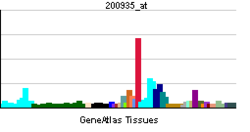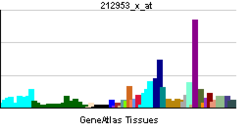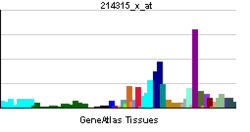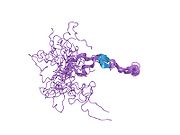- Calreticulin
-
Calreticulin also known as calregulin, CRP55, CaBP3, calsequestrin-like protein, and endoplasmic reticulum resident protein 60 (ERp60) is a protein that in humans is encoded by the CALR gene.[1][2]
Calreticulin is a multifunctional protein that binds Ca2+ ions (a second messenger in signal transduction), rendering it inactive. The Ca2+ is bound with low affinity, but high capacity, and can be released on a signal (see inositol triphosphate). Calreticulin is located in storage compartments associated with the endoplasmic reticulum.[2]
The term "Mobilferrin"[3] is considered to be the same as calreticulin by some sources.[4]
Contents
Function
Calreticulin binds to misfolded proteins and prevents them from being exported from the Endoplasmic reticulum to the Golgi apparatus.
A similar quality-control chaperone, calnexin, performs the same service for soluble proteins as does calreticulin. Both proteins, Calnexin and calreticulin, have the function of binding to oligosaccharides containing terminal glucose residues, thereby targeting them for degradation. In normal cellular function, trimming of glucose residues off the core oligosaccharide added during N-linked glycosylation is a part of protein processing. If "overseer" enzymes note that residues are misfolded, proteins within the RER will re-add glucose residues so that other Calreticulin/Calnexin can bind to these proteins and prevent them from proceeding to the Golgi. This leads these aberrantly folded proteins down a path whereby they are targeted for degradation.
Studies on transgenic mice reveal that calreticulin is cardiac embryonic gene that is essential during development.[5]
Transcription regulation
Calreticulin is also found in the nucleus, suggesting that it may have a role in transcription regulation. Calreticulin binds to the synthetic peptide KLGFFKR, which is almost identical to an amino acid sequence in the DNA-binding domain of the superfamily of nuclear receptors. The amino terminus of calreticulin interacts with the DNA-binding domain of the glucocorticoid receptor and prevents the receptor from binding to its specific glucocorticoid response element. Calreticulin can inhibit the binding of androgen receptor to its hormone-responsive DNA element and can inhibit androgen receptor and retinoic acid receptor transcriptional activities in vivo, as well as retinoic acid-induced neuronal differentiation. Thus, calreticulin can act as an important modulator of the regulation of gene transcription by nuclear hormone receptors.
Clinical significance
Calreticulin binds to antibodies in certain sera of systemic lupus and Sjogren patients that contain anti-Ro/SSA antibodies. Systemic lupus erythematosus is associated with increased autoantibody titers against calreticulin, but calreticulin is not a Ro/SS-A antigen. Earlier papers referred to calreticulin as an Ro/SS-A antigen, but this was later disproven. Increased autoantibody titer against human calreticulin is found in infants with complete congenital heart block of both the IgG and IgM classes.[6]
Role in cancer
Calreticulin (CRT) is expressed in many cancer cells and plays a role to promote macrophages to engulf hazardous cancerous cells. The reason why most of the cells are not destroyed, is the presence of another molecule with signal CD47, which blocks CRT. Hence antibodies that block CD47 might be useful as a cancer treatment. In mice models of myeloid leukemia and non-Hodgkin’s lymphoma, anti-CD47 were effective in clearing cancer cells while normal cells were unaffected.[7]
Interactions
Calreticulin has been shown to interact with Perforin[8] and NK2 homeobox 1.[9]
References
- ^ McCauliffe DP, Zappi E, Lieu TS, Michalak M, Sontheimer RD, Capra JD (July 1990). "A human Ro/SS-A autoantigen is the homologue of calreticulin and is highly homologous with onchocercal RAL-1 antigen and an aplysia "memory molecule"". J. Clin. Invest. 86 (1): 332–5. doi:10.1172/JCI114704. PMC 296725. PMID 2365822. http://www.pubmedcentral.nih.gov/articlerender.fcgi?tool=pmcentrez&artid=296725.
- ^ a b "Entrez Gene: calreticulin". http://www.ncbi.nlm.nih.gov/sites/entrez?Db=gene&Cmd=ShowDetailView&TermToSearch=811.
- ^ MeSH Mobilferrin
- ^ Beutler E, West C, Gelbart T (1997). "HLA-H and associated proteins in patients with hemochromatosis". Mol. Med. 3 (6): 397–402. PMC 2230203. PMID 9234244. http://www.pubmedcentral.nih.gov/articlerender.fcgi?tool=pmcentrez&artid=2230203.
- ^ Michalak M, Lynch J, Groenendyk J, Guo L, Robert Parker JM, Opas M (November 2002). "Calreticulin in cardiac development and pathology". Biochim. Biophys. Acta 1600 (1–2): 32–7. PMID 12445456.
- ^ "Entrez Gene: CALR calreticulin". http://www.ncbi.nlm.nih.gov/sites/entrez?Db=gene&Cmd=ShowDetailView&TermToSearch=811.
- ^ Chao MP, Jaiswal S, Weissman-Tsukamoto R, Alizadeh AA, Gentles AJ, Volkmer J, Weiskopf K, Willingham SB, Raveh T, Park CY, Majeti R, Weissman IL (December 2010). "Calreticulin is the dominant pro-phagocytic signal on multiple human cancers and is counterbalanced by CD47". Sci Transl Med 2 (63): 63ra94. doi:10.1126/scitranslmed.3001375. PMID 21178137. Lay summary – Stanford School of Medicine.
- ^ Andrin, C; Pinkoski M J, Burns K, Atkinson E A, Krahenbuhl O, Hudig D, Fraser S A, Winkler U, Tschopp J, Opas M, Bleackley R C, Michalak M (Jul. 1998). "Interaction between a Ca2+-binding protein calreticulin and perforin, a component of the cytotoxic T-cell granules". Biochemistry (UNITED STATES) 37 (29): 10386–94. doi:10.1021/bi980595z. ISSN 0006-2960. PMID 9671507.
- ^ Perrone, L; Tell G, Di Lauro R (Feb. 1999). "Calreticulin enhances the transcriptional activity of thyroid transcription factor-1 by binding to its homeodomain". J. Biol. Chem. (UNITED STATES) 274 (8): 4640–5. doi:10.1074/jbc.274.8.4640. ISSN 0021-9258. PMID 9988700.
Further reading
- Del Bem LEV (2011). "The evolutionary history of calreticulin and calnexin genes in green plants". Genetica 139 (2): 225–9. doi:10.1007/s10709-010-9544-y. PMID 21222018.
- Coppolino MG, Dedhar S (1998). "Calreticulin". Int. J. Biochem. Cell Biol. 30 (5): 553–8. doi:10.1016/S1357-2725(97)00153-2. PMID 9693955.
- Brucato A, Grava C, Bortolati M et al. (2009). "Congenital Heart Block Not Associated with Anti-Ro/La Antibodies: Comparison with Anti-Ro/La-positive Cases". J. Rheumatol. 36 (8): 1744–8. doi:10.3899/jrheum.080737. PMC 2798588. PMID 19567621. http://www.pubmedcentral.nih.gov/articlerender.fcgi?tool=pmcentrez&artid=2798588.
- Peng RQ, Chen YB, Ding Y et al. (2010). "Expression of calreticulin is associated with infiltration of T-cells in stage IIIB colon cancer". World J. Gastroenterol. 16 (19): 2428–34. doi:10.3748/wjg.v16.i19.2428. PMC 2874150. PMID 20480531. http://www.pubmedcentral.nih.gov/articlerender.fcgi?tool=pmcentrez&artid=2874150.
- Tarr JM, Young PJ, Morse R et al. (2010). "A mechanism of release of calreticulin from cells during apoptosis". J. Mol. Biol. 401 (5): 799–812. doi:10.1016/j.jmb.2010.06.064. PMID 20624402.
- Abd Alla J, Reeck K, Langer A et al. (2009). "Calreticulin enhances B2 bradykinin receptor maturation and heterodimerization". Biochem. Biophys. Res. Commun. 387 (1): 186–90. doi:10.1016/j.bbrc.2009.07.011. PMID 19580784.
- Caramelo JJ, Parodi AJ (2008). "Getting In and Out from Calnexin/Calreticulin Cycles". J. Biol. Chem. 283 (16): 10221–5. doi:10.1074/jbc.R700048200. PMC 2447651. PMID 18303019. http://www.pubmedcentral.nih.gov/articlerender.fcgi?tool=pmcentrez&artid=2447651.
- Du XL, Yang H, Liu SG et al. (2009). "Calreticulin promotes cell motility and enhances resistance to anoikis through STAT3-CTTN-Akt pathway in esophageal squamous cell carcinoma". Oncogene 28 (42): 3714–22. doi:10.1038/onc.2009.237. PMID 19684620.
- Gelebart P, Opas M, Michalak M (2005). "Calreticulin, a Ca2+-binding chaperone of the endoplasmic reticulum". Int. J. Biochem. Cell Biol. 37 (2): 260–6. doi:10.1016/j.biocel.2004.02.030. PMID 15474971.
- Qiu Y, Michalak M (2009). "Transcriptional control of the calreticulin gene in health and disease". Int. J. Biochem. Cell Biol. 41 (3): 531–8. doi:10.1016/j.biocel.2008.06.020. PMID 18765291.
- Zhu Y, Zhang W, Veerapen N et al. (2010). "Calreticulin Controls the Rate of Assembly of CD1d Molecules in the Endoplasmic Reticulum". J. Biol. Chem. 285 (49): 38283–92. doi:10.1074/jbc.M110.170530. PMC 2992262. PMID 20861015. http://www.pubmedcentral.nih.gov/articlerender.fcgi?tool=pmcentrez&artid=2992262.
- Talmud PJ, Drenos F, Shah S et al. (2009). "Gene-centric Association Signals for Lipids and Apolipoproteins Identified via the HumanCVD BeadChip". Am. J. Hum. Genet. 85 (5): 628–42. doi:10.1016/j.ajhg.2009.10.014. PMC 2775832. PMID 19913121. http://www.pubmedcentral.nih.gov/articlerender.fcgi?tool=pmcentrez&artid=2775832.
- Taner SB, Pando MJ, Roberts A et al. (2011). "Interactions of NK cell receptor KIR3DL1*004 with chaperones and conformation-specific antibody reveal a functional folded state as well as predominant intracellular retention". J. Immunol. 186 (1): 62–72. doi:10.4049/jimmunol.0903657. PMC 3129036. PMID 21115737. http://www.pubmedcentral.nih.gov/articlerender.fcgi?tool=pmcentrez&artid=3129036.
- Tarr JM, Winyard PG, Ryan B et al. (2010). "Extracellular calreticulin is present in the joints of patients with rheumatoid arthritis and inhibits FasL (CD95L)-mediated apoptosis of T cells". Arthritis Rheum. 62 (10): 2919–29. doi:10.1002/art.27602. PMID 20533543.
- Kepp O, Gdoura A, Martins I et al. (2010). "Lysyl tRNA synthetase is required for the translocation of calreticulin to the cell surface in immunogenic death". Cell Cycle 9 (15): 3072–7. doi:10.4161/cc.9.15.12459. PMID 20699648.
- Sato H, Azuma Y, Higai K, Matsumoto K (2009). "Altered expression of glycoproteins on the cell surface of Jurkat cells during etoposide-induced apoptosis: shedding and intracellular translocation of glycoproteins". Biochim. Biophys. Acta 1790 (10): 1198–205. doi:10.1016/j.bbagen.2009.05.019. PMID 19524015.
- Hong C, Qiu X, Li Y et al. (2010). "Functional analysis of recombinant calreticulin fragment 39-272: implications for immunobiological activities of calreticulin in health and disease". J. Immunol. 185 (8): 4561–9. doi:10.4049/jimmunol.1000536. PMID 20855873.
- Alur M, Nguyen MM, Eggener SE et al. (2009). "Suppressive Roles of Calreticulin in Prostate Cancer Growth and Metastasis". Am. J. Pathol. 175 (2): 882–90. doi:10.2353/ajpath.2009.080417. PMC 2716982. PMID 19608864. http://www.pubmedcentral.nih.gov/articlerender.fcgi?tool=pmcentrez&artid=2716982.
- Bailey SD, Xie C, Do R et al. (2010). "Variation at the NFATC2 Locus Increases the Risk of Thiazolidinedione-Induced Edema in the Diabetes REduction Assessment with ramipril and rosiglitazone Medication (DREAM) Study". Diabetes Care 33 (10): 2250–3. doi:10.2337/dc10-0452. PMC 2945168. PMID 20628086. http://www.pubmedcentral.nih.gov/articlerender.fcgi?tool=pmcentrez&artid=2945168.
- Nabi MO, Mirabzadeh A, Feizzadeh G et al. (2010). "Novel mutations in the calreticulin gene core promoter and coding sequence in schizoaffective disorder". Am. J. Med. Genet. B Neuropsychiatr. Genet. 153B (2): 706–9. doi:10.1002/ajmg.b.31036. PMID 19760677.
- Schardt JA, Eyholzer M, Timchenko NA et al. (2010). "Unfolded protein response suppresses CEBPA by induction of calreticulin in acute myeloid leukaemia". J. Cell. Mol. Med. 14 (6B): 1509–19. doi:10.1111/j.1582-4934.2009.00870.x. PMID 19659458.
External links
PDB gallery Cell signaling: calcium signaling / calcium metabolism Cell membrane Ion pumpsAdhesion moleculesOtherIntracellular signaling
& calc. regulationSecond messengersChelators and calcium sensorsCalbindin · S100 · pervalbumin · Calretinin · Calsequestrin · Sarcalumenin · Phospholamban · SynaptotagminsCytoskeleton remodeling proteinsCalreticulin · CalnexinOtherCalcium-binding
protein domainsExtracellular ligands Calcium-binding proteins Animal C-type lectinsAsialoglycoprotein receptor · KLRD1 · Collectin (Mannan-binding lectin) · Mannose receptor · proteochondroitin sulfate (Aggrecan, Versican, Brevican, Neurocan)OtherCalnexin · Calreticulin · CD22 · CD33 · Galectin · Myelin-associated glycoprotein · N-Acetylglucosamine receptor · Selectin · SialoadhesinPlant Abrin · Ricin · Mitogens (Concanavalin A, Phytohaemagglutinin, Pokeweed mitogen) · Legume lectin · BanLecCategories:- Human proteins
- C-type Lectins
- Immune system
- Proteins
- Cell signaling
- Signal transduction
Wikimedia Foundation. 2010.







